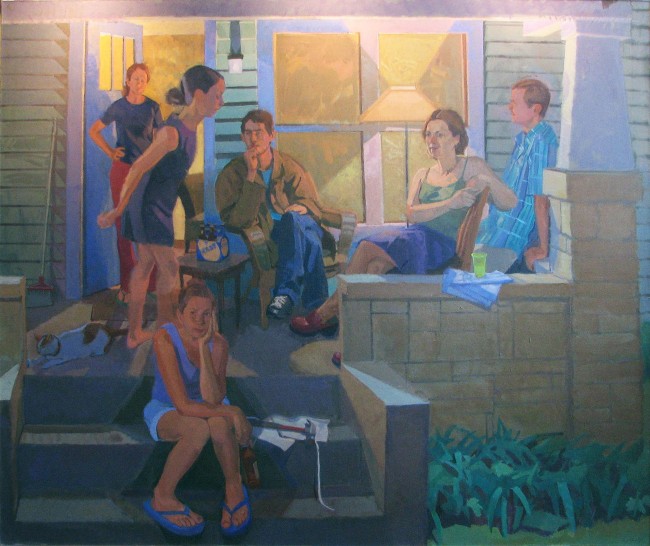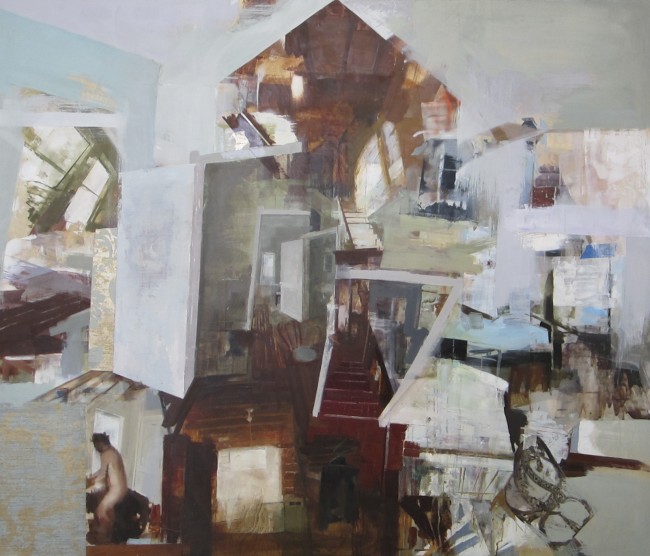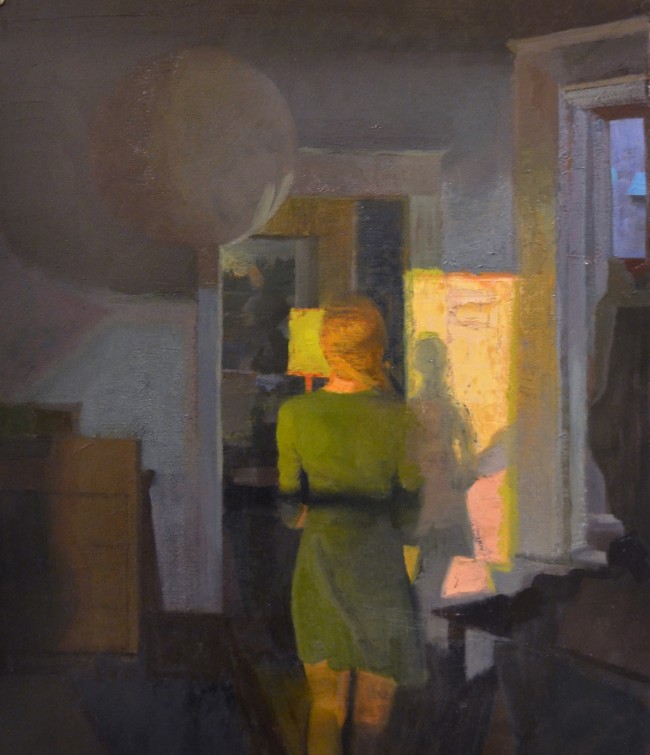Gazes and Shadows:
Continuity and Change: The Return to Figurative Painting
Cincinnati Art Galleries, May 3–June 8
By Jonathan Kamholtz
“Continuity and Change” is a big and ambitious show, curated by Daniel Brown, the Editor of Aeqai who has written about art, been an art dealer, and an independent curator for several decades. The show features seven contemporary painters and takes advantage of a collaboration with the Cincinnati Art Galleries, which has hung four substantial works from its own inventory of late nineteenth and early twentieth centuries—a time when it would have been impossible to contest that figurative work had a clear role towards the top of the hierarchy of painting genres. Despite the show’s title, which proposes that we are witnessing a return to paintings that depict the human body, its strength is not in making an historical argument. Such a show would have required a good deal more space and resources. The show surely succeeds, however, in having found some excellent painters whose use of figurative subject matter suggests the continuing importance of the human form in the western artistic tradition and which raises important issues about the world we live in and the world as it is represented in painting.
It is not primarily a show about the nude, though there are a few, as well as some shirtless men and boys, plus the preponderantly naked ghostly males in Linda Robinson’s haunted houses. And it is not really a portrait show, though again there are a few. But the primary way we see the human face in this show is averted. Rob Anderson’s Jamie is sleeping curled up on a couch with her back to us; Emil Robinson’s Catherine in an orange blouse is turned away, occupied before a mirror with something we can’t see.

And when the faces in these paintings are not averted from us, they are generally averted from each other. In Tim Kennedy’s “Porch at Night,” six figures are tightly bunched between the front door and the stairs of a house in small town or suburban America. A standing lamp has been brought outside; this porch is being colonized into a living room. People are bringing their leisure with them, but also the ease with which they can disconnect from each other into a twilight, outdoor dreaminess. With one exception, they are staring intently almost, but never quite, at each other. The psychological intensity of the painting comes in part from a sense that they each have something important on their minds, but they are unlikely to give up the secret of their obsessions to us. Their dramas may be sexual in origin, though it is a little hard to tell, since Kennedy flattens out the ages of this people a little: girlish figures tend to aspire to the sexuality of women, and Kennedy sees the boyishness in his men. (I thought the same could be said of the figures in Eve Mansdorf’s paintings; are those really kiddies in her “Kiddie Pool”?) There is a solemn glory in their refusal to be read. The woman in the foreground whom I took to be younger looks off and away. It is as if the characters we see (and check out the central figure of the hostess in Kennedy’s “Dessert Buffet”) have just had an important idea come to them, but they are not yet sure what it is. Even when they are looking at each other intensely, as are the three figures in Kennedy’s “Porch” who are engaged in some sort of drama of triangulated desire, it does not look as if they could ever be able to speak or do anything to ease the tension between them.

In Kennedy’s “Dancers,” a couple dances (sort of) in each other’s arms, looking solemnly over each other’s shoulders. I admire their privacy, though I do not envy what might be their estrangement from each other, or in any case, their ennui. But what lives they lead! Kennedy’s figures participate in the glamor of modern middle class life, barely noticing that they are doing so. They can dress for comfort, have a clean room with beautiful light to dance (sort of) in, and are surrounded by beautiful and interesting things. There are pictures on the wall, busts on the mantelpiece, flowers in a vase, and a tie looped over the arm of a rocking chair. A cassette tape is being used to hold open a book to a particular page; at last, a use for them! In some ways, his paintings are as crowded with things, each aspiring to significance, as a Northern Gothic Annunication. If his figures have autonomy from each other, another word for that might be independence; though the things in these people’s lives are currently giving them no visible signs of joy, they indicate that these are people who have had choices.
Eve Mansdorf’s work is as focused on the mysteries of the backyard as Kennedy’s are on the porch and the inside of the house (though for all I know, they could be aspects of the same house, as they are married). In the world she depicts, people fill their lives with bright color, from their love of flowers to their love of bright and garish plastic, which are almost interchangeable in these paintings. (I did not see this as condescending; I thought Brown has assembled a remarkably uncondescending group of artists.) There is something almost epic about “Backyard,” which fooled me initially into thinking that the space behind the house stretched on and on, until I realized it was the contiguous space of several different people’s properties stitched together. A tightly related set of psychic materials permeates Mansdorf’s paintings, and even sometimes the same physical spaces. Look, I thought: there’s that kiddie pool again. A man and a woman are contending with their outdoor duties and pleasures, she bending over on the deck, he standing flat-footed while holding the garden hose as if he had been gobsmocked. Their pleasures, however, do not seem to focus on each other; they are either going about their own business or possibly having a particularly solemn conferral about something. The same man and conceivably the same woman are having an equally solemn “Barbecue” in a different portion of their yard, which sometimes appears huge and sometimes modest to the point of cramped. They stare at the fish curling up on the grill. Could it be with envy?
It is reasonable to wonder whether we are intended to decode or infer a story behind these pictures. In his Curator’s statement, Brown invites us to see a strong connection between figurative painting in general and “narrative figuration,” and perhaps even if the works in the show were not selected for their story-telling potential, an audience still couldn’t help providing them. Isn’t it in our nature to supply at least an interior narrative to all depictions of the figure up to and perhaps even including the studio nude? It seems fair to say that a painting in order to be part of a story-telling mechanism has to find a way to simulate time, a quality that is an essential part of narrative but which has been subject over the centuries of religious, civic, and mythic narratives to a wide variety of pictorial conventions to compress four dimensions into two. In his touching paintings en grisaille, Aidan Schapera gives us portrait busts of women lost in contemplation or having second thoughts about something. His Artist’s Statement suggests that he is thinking specifically of what he calls “the aftermath of a fable,” the post-heroic lives of characters who have been exposed to and participants in great mythic or folkloric dramas. But which ones? The paintings in the show are all without title, so there is no way for us to share in exactly which narratives are being imagined to have shaped the faces that we see. So the strength of the narrative element in his work comes from the invocation of something in the past that we can’t see. Brian Burt’s beach miniatures have found bodies that the bright sun is kind to. They are among the most anecdotal works in the show. With titles like “Throw It!,” “Coming In?,” and “Jump Boy Jump,” they imagine that the painting is in part an extension of a conversation, something we have overheard or might even be saying ourselves. For better or for worse, there is something familiar about these works. They create narrative by a kind of consensus: I know what the story is here, and now you do too.
I am interested in some of the ways that the paintings resist these conventions of narration, virtually erasing the past and often making it hard for the viewers to know just what their relationship to the paintings’ subjects ought to be. They remind me of tableaux, a popular nineteenth century genre in which fully dimensional characters coalesce into positions that sum up in frozen elegance both the actors and the action, the way Sondheim imagines the population of Seurat’s “La Grande Jatte” finally agreeing to take up their positions on the stage as they are on the canvas. This might help shift some of the emphasis from the element of narration to the strange phenomenon that is the pose. And it’s interesting how much posing for a picture—or being depicted as if posing—moves the human condition closer to that of a statue.

Rob Anderson paints his domestic spaces with elegant geometric formality, while his figures insist on the body’s resistance to elegance. In “Jamie Sleeping” (2009), the figure overflows the couch she’s monopolizing; in “Saturday Afternoon” (also 2009), the sleeping figure seems to be burrowing into herself. In “Pick Up Your Shoes” (2009), a shirtless male stands by the back door, contemplating a pair of shoes. He might have a look of childish resentment on his face (and in his body), or he could be Van Gogh having just discovered a great subject. The narrative is intense but opaque, possibly affirming the young man’s artistic autonomy or possibly suggesting the humiliation of receiving infantilizing commands from a partner or a parent. The narrative is further complicated by the title, whose imperative voice adds another “figure” to the picture in the form of a speaker.
“Family Portrait” (2009) squeezes a male, a female, and a dog up against a wall for their sitting. The room, like most of Anderson’s interior spaces, is elegant but abstracted, a Matisse-like vision of space by way, perhaps, of Diebenkorn. Its surfaces are handsomely somewhere between flat and modeled. Anderson says that he hopes that the drama in his work will “come from the use of paint rather than a sensational use of imagery.” His rooms, like his imagery, are spare. They are almost as bare of objects as Kennedy’s interiors were crammed with them. The figures could not look more uncomfortable, except for the dog, who seems at ease with its body even while scratching. Possibly a self-portrait, it seems odd that the painter himself can barely tolerate sitting for himself, unsure where to look or what to do with his hands. Like most of the figures in the show, the man and woman are disengaged from each other and from the viewer. It is tempting to think of this as one of the paintings’ markers of modernity or even post-modernity, but one would also have to remember the impact of Manet’s notoriously theatrical figures. One of the clever bonuses of this show at the Cincinnati Art Galleries is that the four paintings the gallery has selected remind us of how deep are the roots of figurative disengagement. A 19th century picture by Carl Cutler shows a child whose mother seems to be enduring a Millet-like maternal misery; neither is particularly connected to each other or to the viewer. William McGregor Paxton’s full-length “Portrait of Elizabeth Paxton” (1897) depicts Ms. Paxton with her eyes down, attractive, demure, and difficult to read. It’s enough to make you wonder whether what we mean when we think that a figurative work is psychologically engaging is that it’s one where the subject resists our gaze, leaving us free to write the back story, or to settle for our exclusion. In Rob Anderson’s “Five O’clock” (2013), a woman is seated at the corner of a table in a briskly modern interior, quite possibly reading to her child. She is one of the very few figures in the whole show who has been caught in the act of doing work. Behind them on the wall is a painting, perhaps of a stack of books. The paint has been scrubbed so thin that the faces are reduced (or elevated?) to paint alone. It is like a Vuillard without the wallpaper, and with cool light instead of warm. In this public space—a little more like waiting room than a living room—the painter has found a way to give the two figures privacy.

Linda E. Anderson (no relation) writes that she thinks of her paintings as taking us to “haunted spaces,” and notes that their “fragmented interiors feel larger than what a house could contain, like a dream I occasionally have where I discover a secret extra wing in my house….” The spaces in which figures are briefly glimpsed are unfolded, even exploded. There is no horizon line to them, and looking at them is a vertiginous experience. Unlike Tim Kennedy’s paintings, this is not a world filled with loved or even just chosen things. It is a world without clutter that makes you long for stray objects. What sort of beings populate a world in which they have not chosen the things that surround them? There are plenty of staircases, though there is no particular logic to them. Gravity has been superseded, and each portion of each painting obeys a different set of laws about space. We seem to be always standing—or floating—in doorways, looking in, outside and inside at the same time. Why are metal bedframes and polished bare wooden floors so scary? It is like visiting an SRO hotel for ghosts, or perhaps an institution providing care for people whose caregivers are mercifully not in view, though it is certainly also possible that we are being cast in the role of a ghost or an occupant. In “Dollhouse” (2012), we seem to have interrupted a naked figure, just rising, from hiding its things perhaps, or rifling through ours. In “Homegrown” (2013), a pair of twins is (uncharacteristically) confronting us, and they, and we, are being looked at by another, still more ghostly figure. The painterly sketchiness of all the figures serves to remind us of some of the ways that we are reassured and anchored by details.
Emil Robinson is represented by a couple of portraits and eight intriguing works he considers “nocturnes,” which are rooted in both the mundane world of what he calls the “personal domestic experience,” and in the “magical or hallucinatory moment” in which one feels one is “seeing the unseen.” These moments are psychologically and pictorially rich, such as “Looking for a DVD” (2012), where a woman bends over a drawer, deeply engaged in her search, and it seems like she is gradually losing her form, merging into her background a little like a Vuillard bourgeoise. His works are generally the most sensual of the show and even (along with Linda Anderson’s haunting insinuations of privacies violated) the most sexually charged. He paints fabrics brilliantly, like Catherine’s orange blouse or her green dress which float when they might and touch when they must, giving a show of figurative art its strongest presence of the sensual body.
He can invoke the realm of the nightmare, as he does in “Night Visitor” (2012), where a shadow and a lurking silhouette seem to have come from the same place. Considering the nature of this show, it was interesting how infrequently the figurative was strongly defined by its spectral twin, the shadow, which is, like a painting itself, the flattened form of something three dimensional. The sexual presence of the undressing body in “6 AM” emerges out of deep shadows. Robinson is a master of chiaroscuro and uses both to create shapes and strong emotional impact. But he also sees the playfulness of the dark, as he does in “Waiting for the Bathroom” (2012), where the only light in a dark room is the oddly calming bright white of a cell phone.

In Robinson’s “Catherine Walks” (2013), a woman is striding away from us in an apartment from one room to another, a door opened before her invitingly. She is blasted from behind by the bright sun, which helps play up the comparative darkness of the rest of her environment. She is walking towards the shadow she casts on the wall in front of her. Across her back is another shadow, perhaps coming from the divider between the upper and lower halves of the window, that cuts across her waist like a belt. But in the hot shadow towards which she is walking, that dark line fills out and takes more form. It seems to have morphed into an arm, reaching out for the shadow of her hand, grasping for her or caressing her, pulling her back or joining her. It might be the presence of a ghost or it might be the presence of the artist, finding himself in the shadow of the shadows he’s painting. A small masterpiece (30” x 22”), it helps to suggest the richness of the figurative idiom these days.
Thank you very kindly for the thoughtful review. I have learned new things about my work and our show.
Thank you very kindly for the thoughtful review. I have learned new things about my work and our show.